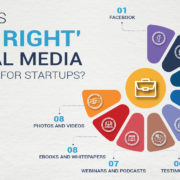It is the dream of every artist to make a living solely off their artwork.
No day job required!
The good news is, that’s now more doable than ever before thanks to the ease of eCommerce solutions.
The bad news is that a lot of people already know this.
As such, there’s a lot of competition out there for quality artwork. As you work hard to achieve your dream, you’re inevitably going to bump into your peers who are doing the exact same thing.
There are a number of steps that you can take to launch your eCommerce art store. By following the instructions laid out in this guide, you’ll be able to hit the ground running after launch with a sizable advantage over your competitors.
Use Social Media
The first step in drawing attention to your eCommerce art store is to pull people in from other platforms.
One of the most effective artwork showcases is social media.
Artwork is shared liberally on social platforms, especially when it speaks to a specific group or cause. You should be pushing your work along social channels like Facebook, Twitter, and Instagram. Include links in your Facebook and Twitter posts to product pages, and direct Instagram users to a link in your bio that will allow them to see more.
Engage with your fans as you cultivate your following. Respond to questions and be accessible. Don’t make it overly obvious that you’re trying to make a sale. Just have a conversation and prove that you’re the kind of artist that people should want to support.
You should also engage with other artists and share some of their work. Inject yourself into the art community as a means of showing people that you’re here for more than just money.
One great tactic that you can use to generate interest on social media is going live on a platform. Set up your phone and go live on Facebook or Instagram while you’re creating art. People can watch along, comment, ask questions, and become invested in your personality and process.
Make this the first stage in your eCommerce video marketing strategy.
Social media is how a lot of artists get started. Develop a devoted following and they will move from social platforms onto your website.
It’s also a great idea to boost some posts on Facebook. This advertising method gives you the ability to specifically target high-value customers who have an interest in your specific area of expertise.
Showcase Your Products in a Unique Way
It’s important that you show off your artwork in a flattering way. This is true on social media but we’re talking about your actual eCommerce store at this point.
That means your product pages have got to be optimized for the user experience. How is your artwork going to catch the eye of a browser? What’s pulling them in? Are your calls to action front and center? A model example of success here is Runners:

You have to make sure that everything is optimized to catch the eye of your customers. That means an optimized checkout page but it also means thinking artistically about your home page and login page.
Both the login page and home page for your store are some of the first spots you’ll have to think about when it comes to creating a positive user experience.
“The user experience starts on your login page” the digital asset management platform, Filecamp, says on its official website. “Make it your own with your logo, color scheme, and a background image that tells your story.”
Also Checkout: Software Asset Management Made Easy: How to Avoid Costly Mistakes
Once you have that done, it’s time to worry about how you’re going to showcase your products. A lot of that decision boils down to understanding who your intended audience might be.
In order to learn how to best showcase your artwork, you’re going to have to do some research on successful eCommerce stores.
Check out LFA capsule fillers, it’s a perfect example of an optimized product catalog. The font is nice and easy to read and there’s nothing to draw the customer’s eyes away from the product. You’ll also notice that the page isn’t overly crowded with distracting colors or obnoxious notifications everywhere.
The more time and attention you invest in the user experience, the more product you’ll be able to move. If someone comes to your eCommerce store, it’s because they already like your artwork. Now, you just have to make the purchase process easy for them.
Start a Blog
Yes, you’re an artist, not a writer. I get that.
But you still need to start a blog for your eCommerce store.
Optimize Your Content
Blogs are necessary for search engine optimization. They’re also another place that you can showcase your personality. Let the audience truly feel like they know you and they will flock to your store, eager to purchase your work.
When you write your blogs, you have to be strategic and do some research before you ever type out the first word.
You’re going to have to look into keyword research before anything else. You have to identify what keywords your audience is searching for. Those terms should also be relevant to your work.
High volume and relevancy are the keys to success when it comes to search terms. Once you know what you’re going to write about, create content that your audience will get something out of. Maybe it’s a series of tutorials about how to start off as an artist. Maybe it’s a series about how artists find inspiration from nature.
Whatever you choose to write about, just make sure that you’re using keywords and not sacrificing readability.
Use Plugins
There are a number of tools that one can use to make blogging easier. Google Docs is a Cloud based word processing program developed by Google. It’s totally free and can be accessed from anywhere — you could even write a blog from a mobile device. And if you’re working along with someone else, it’s possible to collaborate in real time. This helps immensely when you’re trying to blog on the go.
When blogging, you want to make the most of your time. Anything that you can do that will help you complete blog-related tasks faster should be considered. That means working with automation tools and online platforms.
But, if you’re writing your blog on a CMS, you’re going to need an extra step when importing content from Google Docs. Copy and pasting into text editor of your CMS from Google Docs throws off the former’s formatting and can take hours. That’s why you’re going to need a tool like Wordable that will help you adjust the code automatically to make content transfers a simple matter.
When you’re ready to post, you’re able to take that content from Google Docs and pass it through Wordable. Your article will be uploaded in minutes without any confusing and time consuming manual code adjustments.
Keep it Organized
The content is one thing, the layout of your blog is another equally important factor. If it’s completely disorganized with no search function or labels, then no one is going to take the time to sift through the work you’ve done.
All that time spent writing is going to be for nought if no one can make sense of your layout.

Take this sample page from SleepJunkies as a model. All of these articles are organized into sections within a content library. You can easily browse by subject and find what you’re looking for without having to tear through the entire site, rage clicking away in frustration.
Your blog page should be well organized according to the wants and needs of your audience. You could have specific pages that are dedicated to topics that correlate with the main pain points of your customers. This SleepJunkies page does exactly that. People that do business with this company are looking for one thing: to improve their sleep habits.
By having an entire page composed of blog posts that directly deal with sleep research, they’re highlighting key information that customers can get a lot of use out of.
As an artist, you have to determine what your audience is looking for and create a content library that reflects those needs.
Build Links
One last thing that you should keep in mind when you’re blogging.
Linking.
Make sure that your various blogs contain links to one another. The goal is to create an interconnected web of links that both Google and your customers can follow to find various different pieces of content.
You’re also going to need links on other websites that connect back to you.
These are called backlinks, and they’re essential to SEO. Try writing guest blogs that show off your artwork and shop them around to industry pages. These articles should include a link back to your site.
Do this enough times and you’ll create a catalog of high quality backlinks that Google will use to boost you up the search engine ranks.
Manage Your Time
Once you transition your art to either a full time career or side hustle, you’re going to have to wear two hats.
Artist and business person.
That’s where time management comes into play.
There are tools that you can use to help with your time management efforts. Otherwise, you’re liable to lean too far to one side while ignoring the other.
For starters, Google has a free calendar app that lets you carve up your time effectively.
If you need more than that, however, there are a number of paid time management applications that can give you a helping hand.
TimeTackle is a great calendar audit tool that can point you in the right direction, teaching you how to properly manage your time and complete certain tasks. You’re able to categorize events automatically, while also learning from your successes or failures. This will give you a chance to adjust your strategy. If you’re working with a team, you can use TimeTackle to keep the entire team on one schedule.
Both creating new art and marketing your business are important elements of what you do that take up a chunk of your time. But they’re equally important as it pertains to your future success.
You need to produce art and it needs to be of a certain quality to encourage interest.
But you also need to put work into your website, marketing, blogging, and networking efforts if you’re ever going to draw people toward your store.
You have to be organized, carving out blocks of time in which you’ll work on your artwork and periods dedicated to the business side of your eCommerce store.
In Conclusion
It’s very possible to make a living as an eCommerce artist. But it’s going to take a lot of time and effort. Utilize the tips listed above to get your artist eCommerce website off the ground, helping you to live your dream of creating art as a full time job.


